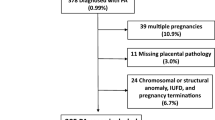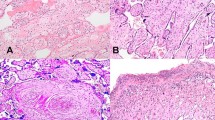Abstract
The uterine location of placenta previa (PP), anterior vs. posterior has an impact on pregnancy outcome. We aimed to study maternal and neonatal outcome and placental histopathology lesions in anterior vs. posterior PP. The medical records and histopathology reports of all singleton cesarean deliveries (CD) performed due to PP, from 24 to 41 weeks, between 12.2008 and 10.2018, were reviewed. Placental lesions were classified into maternal and fetal vascular malperfusion lesions (MVM, FVM), maternal and fetal inflammatory responses (MIR, FIR). Gestational age (GA) at delivery was similar between the anterior PP (n = 67) and posterior PP (n = 105) groups. As compared to the posterior PP group, the anterior PP group had higher rate of previous CD (p < 0.001), placental accreta spectrum (p = 0.04), lower neonatal Hb at birth (p = 0.03), higher rate of neonatal blood transfusion (p = 0.007) and prolonged maternal hospitalization (p = 0.02). Placentas from the anterior PP group had lower weights (p = 0.035), with increased rate of MVM lesions (p = 0.017). The anterior PP location is associated with increased adverse maternal and neonatal outcome, lower placental weights and increased rate of malperfusion lesions. Abnormal placentation in the scarred uterine wall probably has an impact on placental function.
Similar content being viewed by others
Data availability
The data that support the findings of this study are available from the corresponding author upon reasonable request.
References
Oyelese Y, Smulian JC. Placenta previa, placenta accreta, and vasa previa. Obstet Gynecol. 2006;107:927–41. https://doi.org/10.1097/01.AOG.0000207559.15715.98.
Fan D, Wu S, Liu L, Xia Q, Wang W, Guo X, et al. Prevalence of antepartum hemorrhage in women with placenta previa: a systematic review and meta-analysis. Sci Rep. 2017;7. https://doi.org/10.1038/srep40320.
Young BC, Nadel A, Kaimal A. Does previa location matter? Surgical morbidity associated with location of a placenta previa. J Perinatol. 2014;34:264–7. https://doi.org/10.1038/jp.2013.185.
Jang DG, We JS, Shin JU, Choi YJ, Ko HS, Park IY, et al. Maternal outcomes according to placental position in placental previa. Int J Med Sci. 2011;8:439–44. https://doi.org/10.7150/ijms.8.439.
Jauniaux E, Bunce C, Grønbeck L, Langhoff-Roos J. Prevalence and main outcomes of placenta accreta spectrum: a systematic review and metaanalysis. Am J Obstet Gynecol. 2019;221:208–18. https://doi.org/10.1016/j.ajog.2019.01.233.
Marcellin L, Delorme P, Bonnet MP, Grange G, Kayem G, Tsatsaris V, et al. Placenta percreta is associated with more frequent severe maternal morbidity than placenta accreta. Am J Obstet Gynecol. 2018;219:193.e1–9. https://doi.org/10.1016/j.ajog.2018.04.049.
Schneiderman M, Balayla J. A comparative study of neonatal outcomes in placenta previa versus cesarean for other indication at term. J Matern Neonatal Med. 2013;26:1121–7. https://doi.org/10.3109/14767058.2013.770465.
Jang DG, Jo YS, Lee SJ, Lee GSR. Risk factors of neonatal anemia in placenta previa. Int J Med Sci. 2011;8:554–7. https://doi.org/10.7150/ijms.8.554.
Jauniaux E, Burton GJ. Pathophysiology of placenta accreta spectrum disorders: a review of current findings. Clin Obstet Gynecol. 2018;61:743–54. https://doi.org/10.1097/GRF.0000000000000392.
Jansen CHJR, de Mooij YM, Blomaard CM, et al. Vaginal delivery in women with a low-lying placenta: a systematic review and meta-analysis. BJOG An Int J Obstet Gynaecol. 2019;126:1118–26. https://doi.org/10.1111/1471-0528.15622.
Dollberg S, Haklai Z, Mimouni FB, Gorfein I, Gordon ES. Birthweight standards in the live-born population in Israel. Isr Med Assoc J. 2005.
Redline RW, Heller D, Keating S, Kingom J. Placental diagnostic criteria and clinical correlation — a workshop report. Placenta. 2005;26:S114–7. https://doi.org/10.1016/j.placenta.2005.02.009.
Khong TY, Mooney EE, Ariel I, et al. Sampling and definitions of placental lesions Amsterdam placental workshop group consensus statement. In: Archives of Pathology and Laboratory Medicine. ; 2016. https://doi.org/10.5858/arpa.2015-0225-CC
Weiner E, Fainstein N, Schreiber L, Sagiv R, Bar J, Kovo M. The association between umbilical cord abnormalities and the development of non-reassuring fetal heart rate leading to emergent cesarean deliveries. J Perinatol. 2015;35:919–23. https://doi.org/10.1038/jp.2015.102.
Kovo M, Schreiber L, Ben-Haroush A, Cohen G, Weiner E, Golan A, et al. The placental factor in early- and late-onset normotensive fetal growth restriction. Placenta. 2013;34:320–4. https://doi.org/10.1016/j.placenta.2012.11.010.
Weiner E, Miremberg H, Grinstein E, et al. Placental histopathology lesions and pregnancy outcome in pregnancies complicated with symptomatic vs. non-symptomatic placenta previa. Early Hum Dev. 2016. https://doi.org/10.1016/j.earlhumdev.2016.08.012.
Thompson JMD, Irgens LM, Skjaerven R, Rasmussen S. Placenta weight percentile curves for singleton deliveries. BJOG An Int J Obstet Gynaecol. 2007;114:715–20. https://doi.org/10.1111/j.1471-0528.2007.01327.x.
Strong TH, Jarles DL, Vega JS, Feldman DB. The umbilical coiling index. Am J Obstet Gynecol. 1994;170:29–32. https://doi.org/10.1016/S0002-9378(94)70378-7.
Romero R, Kim YM, Pacora P, Kim CJ, Benshalom-Tirosh N, Jaiman S, et al. The frequency and type of placental histologic lesions in term pregnancies with normal outcome. J Perinat Med. 2018;46:613–30. https://doi.org/10.1515/jpm-2018-0055.
Kibel M, Kahn M, Sherman C, Kingdom J, Zaltz A, Barrett J, et al. Placental abnormalities differ between small for gestational age fetuses in dichorionic twin and singleton pregnancies. Placenta. 2017;60:28–35. https://doi.org/10.1016/j.placenta.2017.10.002.
Spinillo A, Gardella B, Adamo L, Muscettola G, Fiandrino G, Cesari S. Pathologic placental lesions in early and late fetal growth restriction. Acta Obstet Gynecol Scand. 2019;98:1585–94. https://doi.org/10.1111/aogs.13699.
Jing L, Wei G, Mengfan S, Yanyan H. Effect of site of placentation on pregnancy outcomes in patients with placenta previa. PLoS One. 2018;13:e0200252. https://doi.org/10.1371/journal.pone.0200252.
Cao Y, Wei Y, Yu Y, Wang Z. Safety and efficacy of a novel three-dimensional magnetic resonance imaging model for uterine incision in placenta previa. Int J Gynecol Obstet. 2017;139:336–41. https://doi.org/10.1002/ijgo.12311.
Kayem G, Davy C, Goffinet F, Thomas C, Cléent D, Cabrol D. Conservative versus extirpative management in cases of placenta accreta. Obstet Gynecol. 2004;104:531–6. https://doi.org/10.1097/01.AOG.0000136086.78099.0f.
Kotsuji F, Nishijima K, Kurokawa T, Yoshida Y, Sekiya T, Banzai M, et al. Transverse uterine fundal incision for placenta praevia with accreta, involving the entire anterior uterine wall: a case series. BJOG An Int J Obstet Gynaecol. 2013;120:1144–9. https://doi.org/10.1111/1471-0528.12252.
Roberge S, Boutin A, Chaillet N, Moore L, Jastrow N, Demers S, et al. Systematic review of cesarean scar assessment in the nonpregnant state: imaging techniques and uterine scar defect. Am J Perinatol. 2012;29:465–72. https://doi.org/10.1055/s-0032-1304829.
Bustamante Helfrich B, Chilukuri N, He H, Cerda SR, Hong X, Wang G, et al. Maternal vascular malperfusion of the placental bed associated with hypertensive disorders in the Boston Birth Cohort. Placenta. 2017;52:106–13. https://doi.org/10.1016/j.placenta.2017.02.016.
Brosens I, Dixon HG, Robertson WB. Fetal growth retardation and the arteries of the placental bed. BJOG An Int J Obstet Gynaecol. 1977;84:656–63. https://doi.org/10.1111/j.1471-0528.1977.tb12676.x.
Tarca AL, Romero R, Benshalom-Tirosh N, Than NG, Gudicha DW, Done B, et al. The prediction of early preeclampsia: results from a longitudinal proteomics study. PLoS One. 2019;14:e0217273. https://doi.org/10.1371/journal.pone.0217273.
Parra-Saavedra M, Simeone S, Triunfo S, Crovetto F, Botet F, Nadal A, et al. Correlation between histological signs of placental underperfusion and perinatal morbidity in late-onset small-for-gestational-age fetuses. Ultrasound Obstet Gynecol. 2015;45:149–55. https://doi.org/10.1002/uog.13415.
Triunfo S, Lobmaier S, Parra-Saavedra M, Crovetto F, Peguero A, Nadal A, et al. Angiogenic factors at diagnosis of late-onset small-for-gestational age and histological placental underperfusion. Placenta. 2014;35:398–403. https://doi.org/10.1016/j.placenta.2014.03.021.
Parra-Saavedra M, Crovetto F, Triunfo S, Savchev S, Peguero A, Nadal A, et al. Placental findings in late-onset SGA births without Doppler signs of placental insufficiency. Placenta. 2013;34:1136–41. https://doi.org/10.1016/j.placenta.2013.09.018.
Balayla J, Desilets J, Shrem G. Placenta previa and the risk of intrauterine growth restriction (IUGR): A systematic review and meta-Analysis. J Perinat Med. 2019;47:577–84. https://doi.org/10.1515/jpm-2019-0116.
Author information
Authors and Affiliations
Contributions
The authors state that each of the authors have provided substantial contribution and are in agreement with all aspects of the final manuscript.
Corresponding author
Ethics declarations
Ethics approval and consent to participate
All procedures were in accordance with the ethical standards of the institutional Review Board and with the 1964 Helsinki declaration and its later amendments or comparable ethical standards. Decision number 9-2010-0223 dated 18/03/2019.
Conflict of interest
All authors declare no competing interests.
Additional information
Publisher’s Note
Springer Nature remains neutral with regard to jurisdictional claims in published maps and institutional affiliations.
Supplementary Information
ESM 1
(XLSX 22 kb)
Rights and permissions
About this article
Cite this article
Tairy, D., Weiner, E., Schreiber, L. et al. Placental Lesions and Pregnancy Outcome in Anterior as Compared to Posterior Placenta Previa. Reprod. Sci. 28, 3241–3247 (2021). https://doi.org/10.1007/s43032-021-00558-7
Received:
Accepted:
Published:
Issue Date:
DOI: https://doi.org/10.1007/s43032-021-00558-7




